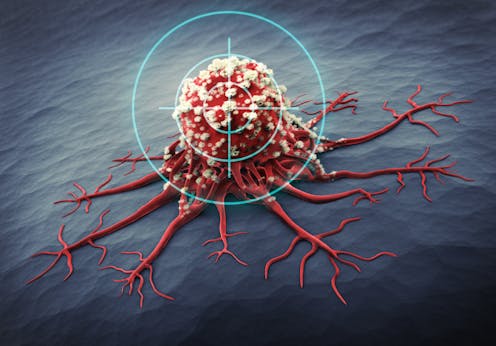
Radiotherapy has been a cornerstone of cancer treatment for decades, offering a targeted approach to treat tumours. Yet, as effective as it is, it often causes unwanted damage to neighbouring healthy tissues – which can lead to many side-effects.
But a new technique researchers are developing, which uses narrow X-ray beams, could offer a promising alternative method for treating cancer. The therapy could potentially be just as effective as conventional radiotherapy – and with fewer complications. It’s known as microbeam radiation therapy.
Microbeams were initially studied in the 1960s to examine cosmic radiation. But it was not until the 1980s that their potential for treating cancer was explored. Although research into microbeam therapy has only so far been conducted in preclinical models, these studies have shown it to be a very successful technique for treating a variety of cancers – and with many advantages over radiotherapy as it is.
With conventional radiotherapy, the radiation is spread broadly across the tumour in order to kill the cancerous tissue. But this also means more chances to damage some of the healthy, surrounding tissue – with more adverse symptoms.
Microbeam radiation therapy uses extremely narrow beams (even narrower than a human hair) that are closely spaced together. These high-intensity x-ray beams are delivered in very short bursts – just a fraction of a second. This leads to alternating zones of high radiation (“peaks”) and low radiation (“valleys”) – much like the teeth of a comb. Although the microbeams still inevitably affect the normal tissues, they don’t cause as much damage as broad radiotherapy beams.
The design of microbeam radiation therapy is based on the “dose-volume effect”. This shows that reducing the volume of tissue exposed to radiation increases the nearby, normal tissue’s tolerance to damage. But tumour tissues are still affected as they’re less able to repair damage compared to normal ones.
The quick delivery of this treatment is essential, as even small body movements – such as breathing or a heartbeat – can blur this precise pattern, reducing its ability to spare healthy tissue.
Effects of microbeams
Preclinical studies on animals have shown that microbeam radiation therapy can significantly slow cancer growth by limiting the tumour’s ability to repair damage quickly. Healthy, nearby tissues were still able to repair themselves after microbeam exposure.
Animal studies have also shown microbeam radiation therapy to be effective in treating a range of tumours – including tumours in the central nervous system, breast and skin. Due to the central nervous system’s high tolerance to microbeams, the therapy has also been tested as a tool to reduce brain over-activity in treating neurological conditions – such as epilepsy.

This therapy appears to be particularly beneficial for treating tumours in sensitive areas such as the brain, since it mainly targets the tumour’s tissues. This means less normal tissues damage, and less complications – unlike current radiotherapy, which can cause neurocognitive effects such as memory loss. This could make microbeam radiation therapy an especially critical treatment for children with brain and central nervous system tumours – as their developing brains are more vulnerable to radiation damage.
Another reason why microbeam radiation therapy could be more effective than conventional radiotherapy is because of the way the ultra-high speed delivery of the radiation depletes oxygen inside the cells. This depletion creates a temporary low-oxygen environment, which makes cells more resistant to the radiation. But because tumour cells are often already in low-oxygen areas, they’re still vulnerable to treatment.
Next steps
Microbeam radiation therapy is still in the experimental phase. This means it has not yet been used to treat human patients.
This is partly because the therapy needs advanced facilities, called synchrotrons, in order to create the right type of microbeams. These facilities are expensive, rare and not suitable for daily clinical use as their main scope at the moment is research.
But more compact sources are being developed – which could potentially produce microbeams with suitable characteristics. They could also be used in hospitalised environments.
There’s still much to uncover about microbeam radiation therapy – such as some of the radiobiological processes behind its effects and how to combine it effectively with existing therapies. There is also a lot of work going on to scale up the technology for clinical use. These questions must be answered before we can use this treatment safely on patients.
But as research and technology continue to evolve, these advances will bring us closer to an effective treatment. It’s remarkable to think that such narrow beams of radiation could have such a profound impact on how we fight cancer.
Nothing to declare.
This article was originally published on The Conversation. Read the original article.







